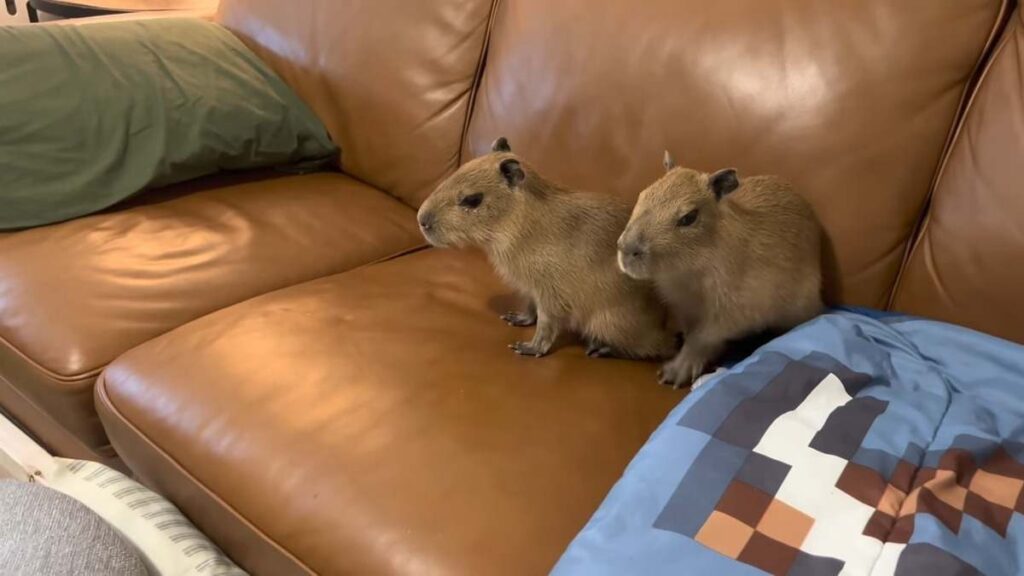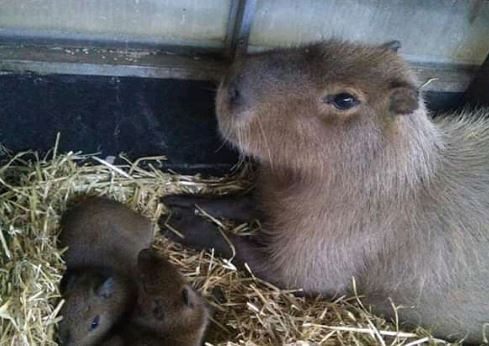As the largest rodents in the world, capybaras have gained popularity as exotic pets in some regions. However, people often ask if they can be litter trained when keeping them as pets.
Litter training involves teaching an animal to use a designated area for urination and defecation, like a cat. This article will address the common question of litter training a capybara. We will also explore the benefits of litter training and more.
It is possible to litter train a capybara; you must know that it is a relatively challenging task. Their natural inclination is to eliminate water or grassy areas. This behavior is deeply rooted in their instincts and can be challenging to modify.
However, there have been instances where capybara owners have successfully litter-trained their pets. These owners implemented various techniques and strategies to encourage their capybaras to use a designated litter area. Some used large litter boxes or shallow pools filled with sand or grass, mimicking Capybara’s natural preferences.
Several factors contribute to litter training capybara success rates. Here are some of the factors below.
- Patience and Consistency: Litter training for capybaras requires patience and consistency. Capybaras take time to understand and adjust to the concept of a designated elimination area. Consistently reinforcing positive behavior and providing regular training sessions will help them learn the desired behavior over time.
- Positive reinforcement: Positive reinforcement is an effective tool when training capybaras. Rewarding them with treats, praise, or playtime when they use the litter box or designated area helps them associate the behavior with desirable outcomes. This encourages them to repeat the desired behavior and increases litter training chances.
- Understanding Natural Instincts and Preferences: Capybaras have innate instincts and preferences for eliminating. They are more likely to do so in the water or grassy areas. Understanding and accommodating these instincts can help litter training. Providing a litter box or designated area that mimics their natural preferences, such as sand or grass, will increase their willingness to use it for elimination.
Litter Training Techniques for Capybaras That Works
Several litter training techniques or steps work for pets like capybaras. Here are some of them below.
- Provide a Suitable Litter Box: Choose a large litter box that fits capybaras comfortably. The box should be easily accessible and have low sides for easy entry and exit. Use a litter material that resembles the capybara’s natural preferences, such as sand, grass, or a combination of both.
- Observe and Identify Preferred Elimination Areas: Observe your capybara’s behavior and identify areas where they tend to eliminate naturally. This could be a particular spot in their enclosure or a water feature they use for urination. Place the litter box in or near these preferred areas to encourage their association with the desired elimination spot.
- Positive reinforcement: Use positive reinforcement techniques to encourage your capybara to utilize the litter box. Whenever your capybara successfully uses the litter box, give him praise, affection, or small treats as a reward. This favorable association will reinforce desired behavior and encourage them to utilize the litter box consistently.
- Maintain Cleanliness: Capybaras are naturally tidy animals and prefer healthy environments for elimination. Regularly clean and maintain the litter box to ensure freshness and odor-freeness. Capybaras are more likely to use a clean litter box, so removing waste promptly and replacing litter material when needed is essential.
- Supervision and Correction: Initially, closely supervise your capybara’s behavior and redirect them to the litter box if they show signs of eliminating outside of it. Avoid scolding or punishing your capybara if accidents occur, which can create negative associations. Instead, calmly and gently guide them back to the litter box, providing positive reinforcement when they use it correctly
Benefits and Considerations of Litter Training Capybaras
There are several benefits to litter training capybaras. Here are some of the benefits below.
- Hygiene and cleanliness: Litter training allows capybaras to have a designated elimination area. This promotes cleanliness in their living space. It helps keep their enclosure clean and makes waste management easier for caretakers.
- Convenience for caretakers: Litter training simplifies waste cleanup. Instead of cleaning the entire enclosure, they can focus on regularly maintaining and cleaning the litter box.
- Reduced odor: By encouraging capybaras to use a specific area for elimination, litter training controls waste odors. This can create a more pleasant environment for capybaras and caretakers.
While there are several benefits to litter training this rodent, there are also several things you must consider when litter training them. Here are some of them below.
- Individual preference and adaptability: Not all capybaras readily adapt to litter training. Each capybara has its own personality and preferences; some may take longer to adjust to the concept. It’s imperative to be patient and understanding, providing positive reinforcement and allowing for individual differences.
- Consistency and reinforcement: Successful litter training requires consistency in training efforts and reinforcement of desired behavior. Capybaras need time and repeated training to grasp the concept fully and consistently use the litter box.
- Natural instincts: Capybaras eliminate in water or grassy areas. While they can be trained to use a litter box, it’s imperative to consider their innate preferences when selecting litter materials or designing the litter box setup. Mimicking their instincts can improve litter training.
Challenges and Limitations of Litter Training Capybaras

If you are litter-training these rodents for the first time, there are several challenges and limitations you will experience. Here are some of them below.
- Size and messiness: Capybaras are large animals whose waste can be substantial. Managing and cleaning the litter box can be more challenging than for smaller pets. The litter box must be adequately sized and equipped to accommodate their needs.
- Water preference: Capybaras naturally eliminate in water. While litter training can redirect this behavior, some capybaras may still prefer water as their primary elimination area. This makes litter training more challenging and may require additional training techniques or adaptations.
- Limited control: Capybaras have limited control over their bladder and bowel movements, especially when young. This can make it difficult for them to use the litter box consistently. It may require frequent monitoring and patience during the training process.
In addition to these limitations, litter-trained capybaras have several hygiene and health considerations. Below are some of them.
Cleanliness of the litter box: Regular cleaning is essential for proper hygiene. Capybaras produce a significant amount of waste, so frequent waste removal and regular litter replacement are necessary to prevent odors, bacterial growth, and potential health issues.
Use safe and appropriate litter: Choose a litter that is safe for capybaras and does not pose health risks. Avoid clumping cat litter or litter made of harmful materials such as cedar or pine, as these are toxic to capybaras. Opt for non-toxic, natural, and absorbent materials like paper-based or wood-based pellets.
Monitoring for urinary tract infections: Capybaras are susceptible to urinary tract infections (UTIs). Litter-trained capybaras should be closely monitored for any signs of UTIs, such as frequent urination, straining to urinate, blood in the urine, or changes in behavior. If you observe any concerned behavior, contact the vet doctor immediately
Expert Advice and Tips for Successful Capybara Litter Training
Here are some Expert Advice and Tips to improve litter training chances.
- Start early and be consistent: Begin the litter training process as early as possible when your capybara is young. Consistency is the key to good habits. Set a routine and stick to it, providing ample opportunities for your capybara to use the litter box.
- Choose the right litter box and location: Select a litter box that is spacious enough for your capybara to use comfortably. Place the litter box in a quiet, easily accessible area, away from their sleeping or feeding areas. Capybaras prefer privacy, so a secluded corner or designated space can encourage them to use the litter box.
- Positive reinforcement and rewards: Use positive reinforcement techniques to encourage your capybara to utilize the litter box. Reward them with treats or praise whenever they successfully use the litter box. This helps them associate behavior with positive experiences.
Other tips include a gradual introduction to the litter box, patience and understanding with the capybaras, and a lot more.
Conclusion
Although litter training a capybara is possible, it is a relatively challenging task as these rodents are wired to eliminate in water or grassy areas naturally. Litter training can be done using different techniques and methods. We have discussed these methods in this article.
We have also explored the benefits of litter training your capybara and the challenges you will experience. Read through this blog post to get all the details you need.


![Capybara Meat And Its Culinary Uses - [Every You Should Know] Capybara Meat & Culinary Uses](https://capybaratips.com/wp-content/uploads/2023/03/Capybara-meat-250x200.webp)


![Where Can I Buy a Capybara Near Me? - [Recommended] Where Can I Buy a Capybara Near Me](https://capybaratips.com/wp-content/uploads/2023/03/Near-Me-250x200.webp)
![How To Get A Capybara In China [Steps By Steps] China-Capybara](https://capybaratips.com/wp-content/uploads/2023/03/China-Capybara-250x200.webp)
![How To Get a Pet Capybara Uk [Step By Step] How To Get a Pet Capybara Uk](https://capybaratips.com/wp-content/uploads/2023/03/Uk-Capybara-250x200.webp)

